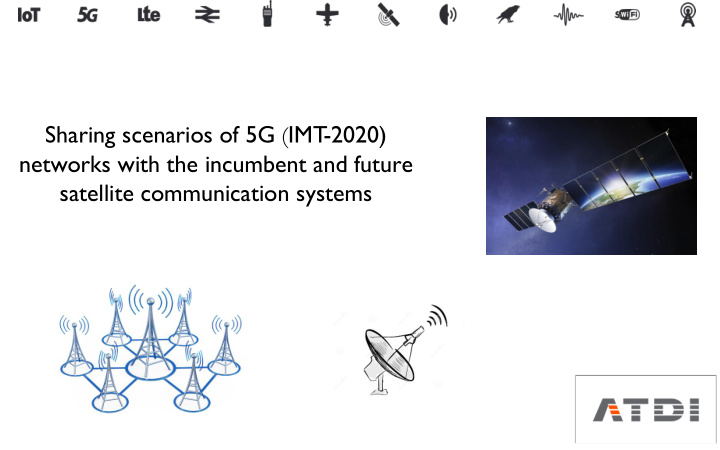



Sharing scenarios of 5G ( IMT -2020) networks with the incumbent and future satellite communication systems
AGENDA AGENDA Past and Present: IMT VS. FSST 5GT Satellite Communications Future: IMT AND FSST
AGENDA Past and Present: IMT VS. FSST
IMT, FSS: WRC-15 Outcome WRC-15 AI 1.1: IMT Identification, C-band specific: 3400-3600 MHz: Global allocation to IMT, except some APT countries 3600-3700 MHz: No IMT, except 4 CITEL countries 3700-4200 MHz : No IMT Note: The 3600-3800 MHz band is harmonized for IMT use throughout the European Union by European Decision.
WRC-19 Agenda Item 1.13 – further spectrum identification for IMT ▪ Over 33 GHz of spectrum are under study ▪ Potential identification of IMT in frequency bands where FSS is allocated as a primary service: Candidate band Potential sharing band Allocation in ITU Region 1 24.25-27.5 GHz 24.65-25.25 GHz FSS (E-s) 37.5-40.5 GHz 37.5-40.5 GHz FSS (s-E) 40.5-42.5 GHz 40.5-42.5 GHz FSS (s-E) 42.5-43.5 GHz 42.5-43.5 GHz FSS (E-s) Note : the 24.25- 27.5 GHz (“the 26 GHz band”) has been identified as a pioneer band for 5G mm-wave use in Europe.
AGENDA 5GT
5G Overview 5G is expected to address three key usage scenarios: Enhanced Mobile Broadband: an evolution beyond 4G to provide multi-gigabit per second (Gbps) data rates for applications like virtual reality, UHD video streaming, and more M2M: Ultra-reliable communications: Including the ability to support a low latency (sub-1ms) and high massive number of low cost IoT availability, reliability and security to connections with very long support services such as battery life and wide coverage autonomous vehicles and remote including inside buildings surgeries
5G Case for more spectrum Above 24 GHz : The availability of wide contiguous bands, which would allow the use of wider bandwidth channels (100 – 500 MHz or more), and advanced antenna technologies: ▪ Significantly higher data rates to be delivered in areas of very high MBB traffic density. ▪ Better range and reliability 1-6 GHz bands: Offers a good mixture of coverage and capacity benefits. Specifically, the C-band (3.3-3.8 GHz) is expected to form the basis of many initial 5G services, which will later on spread into higher frequencies .
AGENDA Satellite Communications
Satellite applications overview IP satellite video and hybrid broadcast- TV Broadcast broadband Fixed VSAT Comms on the move (planes, cars, ships, trains) Content Distribution Consumer Broadband Government and Military Mobile Backhaul Satcom M2M Communications Safety services
Satellite Case for Spectrum Above 24 GHz: ▪ Traditional applications demand more BW: Increased demand for TV services in HD format, and deployment of UHD ▪ New applications and non-GSO constellations demand higher data rates: A shift towards Ka-band, and later to 40 GHz (V-band), is expected ▪ C and Ku-bands are highly congested, while finding a space in the traditional Ka-band for a new system is also becoming a challenge C-band: ▪ Wide coverage ▪ Favorable propagation characteristics ▪ Heavily used by satellites for decades
AGENDA Future: IMT AND FSS
5G and FSS : C-band sharing scenario 5G BS parameters: Power: 5W Carrier BW: 20 MHz Gain: 5 dBi Rooftop antenna 2m FSS ES parameters: Antenna Gain: 34 dBi Carrier BW: 1 MHz 5G station is to be located at 1-12 km away from satellite ES to meet the criteria for compatibility
5G vs FSS : mm-wave bands 5G BS parameters: Power: 5W Carrier BW: 100 MHz Gain: 5 dBi Rooftop antenna 2m FSS ES parameters: Antenna Gain: 45 dBi Carrier BW: 100MHz Power: 100W Red contour: 5G BS “restricted” area around FSS ES at 40 GHz much smaller than in C-band! Blue coverage: Transmitting ES exceeds the compatibility criteria to a 5G BS at 25 GHz
5G and FSS frequency sharing: a glance into the future Past experience Future of 5G and FSS co-existence: ▪ Technical difficulties to implement ▪ Higher frequency bands are frequency sharing easier to share ▪ Applications overlap is not significant ▪ Satellites will be an important ▪ Winner takes it all approach: mobile part of the 5G ecosystem “attack” and satellite “defend” ▪ Frequency bands under spectrum discussions are of little current use
5G and FSS frequency sharing: Conclusion The technical analysis of the satellite vs 5G co-existence is becoming increasingly relevant The use of appropriate radio engineering tools is mandatory for informed decisions on this case of frequency sharing: ▪ 5G and satellite communication features implemented in one tool ▪ Interface with most updated databases of 5G and space/earth stations
11 Boulevard Malesherbes, 75008 Paris FRANCE T el +33 (0)1 53 30 81 41 Fax +33 (0)1 53 30 81 49 Thank you! Хвала!
Recommend
More recommend